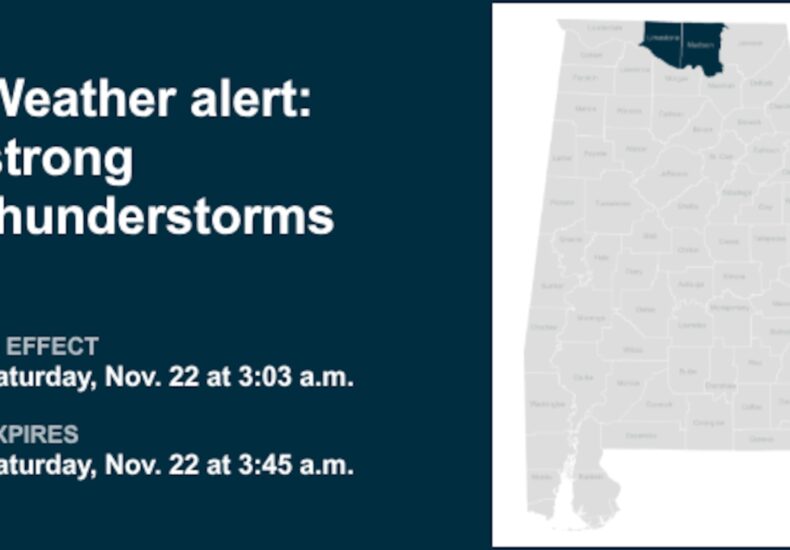
Weather alert issued for strong thunderstorms in Limestone and Madison counties until 3 a.m. Saturday
A report was issued from the National Weather Service on Saturday at 3: 03 a. m. for strong thunderstorms until 3: 45 a. m. for Limestone and Madison counties. Residents may experience wind gusts of up to 40 mph. “At 3: 02 a. m., Doppler radar tracked a strong thunderstorm over Tanner, or near Athens, moving east at 45 mph,” says the weather service. “Gusty winds could knock down tree limbs and blow around unsecured objects.” Locations impacted by the alert include Huntsville, Madison, Athens, University Of Alabama In Huntsville, Tanner, Harvest, French Mill, Capshaw and Ripley. The weather service comments, “If outdoors, consider seeking shelter inside a building.” Preparing for impending lightning strikes: Expert safety recommendations Each year, lightning strikes the United States approximately 25 million times, mostly during the summer. It claims the lives of about 20 people annually, according to the weather service. The threat of lightning becomes more pronounced as thunderstorms draw nearer, peaking when the storm is directly overhead and gradually waning as it moves away. To ensure your safety during a thunderstorm, keep these recommendations in mind: Lightning safety plan: When venturing outdoors, it’s crucial to have a lightning safety plan in place. Stay vigilant by monitoring the sky for ominous signs and listening for the telltale sound of thunder. If thunder is audible, it’s a clear indication of nearby lightning. Seek a safe place to shelter, preferably indoors. Indoors safety measures: Once you’re indoors, avoid using corded phones, electrical devices, plumbing fixtures, and stay away from windows and doors. Lightning can follow conductive pathways, and these precautions reduce the risk of electrical surges. Wait for the all-clear: After the last lightning strike or thunderclap, wait at least 30 minutes before resuming outdoor activities. Lightning can strike even when a storm has seemingly passed, so exercise caution. When indoor shelter isn’t available: If you find yourself outdoors with no access to indoor shelter during a thunderstorm, take these steps to maximize your safety: Avoid open fields, hilltops, or ridge crests, as they expose you to greater lightning risk. Steer clear of tall, isolated trees and other prominent objects. In forested areas, stay close to lower stands of trees. If you’re with a group, ensure individuals are spread out to prevent lightning current from transferring between people. Camping in an open setting during a thunderstorm is strongly discouraged. If you have no alternative, set up camp in a valley, ravine, or other low-lying areas. It’s crucial to note that a tent provides no protection against lightning. Do not approach water bodies, wet objects, or metal items. While water and metal don’t attract lightning, they conduct electricity effectively and can pose significant risks. In summary, when facing the threat of lightning, vigilance and preparedness are your best allies. By following these guidelines, you can significantly reduce the chances of lightning-related accidents and prioritize your safety. Driving through downpours: Safety guidelines for wet roads When heavy rain sets in, the risk of flooding and hazardous driving conditions rises. Whether it’s prolonged rainfall or rapid runoff, being prepared is essential. Here are some valuable safety tips from the weather service to ensure you stay safe in heavy rain: Beware of swollen waterways: During heavy rain, avoid parking or walking near culverts or drainage ditches, where swift-moving water can pose a serious risk. Maintain safe driving distances: Adhere to the two-second rule for maintaining a safe following distance behind the vehicle in front of you. In heavy rain, allow an additional two seconds of distance to compensate for reduced traction and braking effectiveness. Reduce speed and drive cautiously: If it is raining and the roads are wet, slow down. Take your foot off the accelerator and let your speed drop gradually. Never use the brakes suddenly because this may cause the car to skid. Choose your lane wisely: Stick to the middle lanes to minimize the risk of hydroplaning. Outer lanes are more prone to accumulating water. Prioritize visibility Enhance your visibility in heavy rain by turning on your headlights. Watch out for vehicles in blind spots, as rain-smeared windows can obscure them. Watch out for slippery roads: Be extra careful during the first half hour after rain begins. Grime and oil on the road surface mix with water to make the road slippery. Keep a safe distance from large vehicles: Large trucks and buses can reduce your visibility with tire spray. Avoid tailgating and pass with caution. Mind your windshield wipers: Overloaded wiper blades can hinder visibility. If rain severely impairs your vision, pull over and wait for conditions to improve. Seek refuge at rest areas or sheltered spots. If the roadside is your only option, pull off as far as possible, preferably past the end of a guard rail, and wait until the storm passes. Keep your headlights on and turn on emergency flashers to alert other drivers of your position. In the face of heavy rain, these precautions can make a significant difference in ensuring your safety on the road. Remember to stay informed about weather conditions and heed guidance from local authorities for a secure journey.
https://www.al.com/weather-alerts/2025/11/weather-alert-issued-for-strong-thunderstorms-in-limestone-and-madison-counties-until-3-a-m-saturday.html
You may also like
You may be interested
Globe bets on prepaid fiber, sets expansion
No content was provided to convert. Please provide the text...
Bragging rights up as Samal makes 5150 debut
A stellar Open division field will be shooting for the...
DigiPlus launches P1-M surety bond program
MANILA, Philippines — DigiPlus Interactive Corp. has partnered with Philippine...
 The New York Times
The New York Times
- What Is Trump’s 28-Point Plan to End Russia’s War in Ukraine? 2025 年 11 月 22 日 Paul Sonne and Ivan Nechepurenko
- In One Week, Trump Moves to Reshape U.S. Environmental Policy 2025 年 11 月 22 日 Maxine Joselow
- Trump Offers a Ukraine Peace Plan the Kremlin Can Love 2025 年 11 月 22 日 David E. Sanger
- The A.I. Boom Is Driving the Economy. What Happens if It Falters? 2025 年 11 月 22 日 Ben Casselman and Sydney Ember
- Trump Claims a White ‘Genocide’ in South Africa. Here’s What’s Really Happening. 2025 年 11 月 22 日 John Eligon and Joao Silva
- Germans Are Going Off Beer. That’s Forcing Brewers to Adapt or Go Bust. 2025 年 11 月 22 日 Clay Risen
- Cargo Ship Fire in L.A. Threatens City With Hazardous Smoke 2025 年 11 月 22 日 Shawn Hubler and Francesca Regalado
- What to Know About the Nearly 10% Climb in a Key Medicare Expense for 2026 2025 年 11 月 22 日 Mark Miller
- U.S. Defends Decision to Seek Death Penalty for Luigi Mangione 2025 年 11 月 22 日 Benjamin Weiser and Hurubie Meko
- Marjorie Taylor Greene Says She Will Resign in January, After Break From Trump 2025 年 11 月 22 日 Annie Karni



Leave a Reply